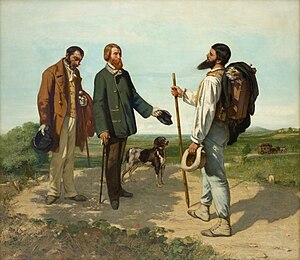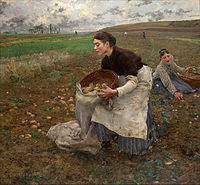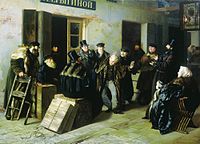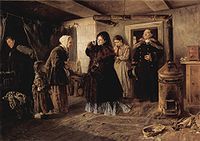Realism (art movement)

Realism was an artistic movement that began in France in the 1850s, after the 1848 Revolution.[1] Realists rejected Romanticism, which had dominated French literature and art since the late 18th century. Realism revolted against the exotic subject matter and exaggerated emotionalism and drama of the Romantic movement. Instead it sought to portray real and typical contemporary people and situations with truth and accuracy, and not avoiding unpleasant or sordid aspects of life. Realist works depicted people of all classes in situations that arise in ordinary life, and often reflected the changes brought by the Industrial and Commercial Revolutions. The popularity of such "realistic" works grew with the introduction of photography—a new visual source that created a desire for people to produce representations which look objectively real.
The Realists depicted everyday subjects and situations in contemporary settings, and attempted to depict individuals of all social classes in a similar manner. Classical idealism and Romantic emotionalism and drama were avoided equally, and often sordid or untidy elements of subjects were not smoothed over or omitted. Social realism emphasizes the depiction of the working class, and treating them with the same seriousness as other classes in art, but realism, as the avoidance of artificiality, in the treatment of human relations and emotions was also an aim of Realism. Treatments of subjects in a heroic or sentimental manner were equally rejected.[2]
Realism as an art movement was led by Courbet in France. It spread across Europe and was influential for the rest of the century and beyond, but as it became adopted into the mainstream of painting it becomes less common and useful as a term to define artistic style. After the arrival of Impressionism and later movements which downgraded the importance of precise illusionistic brushwork, it often came to refer simply to the use of a more traditional and tighter painting style. It has been used for a number of later movements and trends in art, some involving careful illusionistic representation, such as Photorealism, and others the depiction of "realist" subject matter in a social sense, or attempts at both.
Beginnings in France

The Realist movement began in the mid-19th century as a reaction to Romanticism and History painting. In favor of depictions of 'real' life, the Realist painters used common laborers, and ordinary people in ordinary surroundings engaged in real activities as subjects for their works. The chief exponents of Realism were Gustave Courbet, Jean-François Millet, Honoré Daumier, and Jean-Baptiste-Camille Corot.[3][4][5] Jules Bastien-Lepage is closely associated with the beginning of Naturalism, an artistic style that emerged from the later phase of the Realist movement and heralded the arrival of Impressionism.[6]
Realists used unprettified detail depicting the existence of ordinary contemporary life, coinciding in the contemporaneous naturalist literature of Émile Zola, Honoré de Balzac, and Gustave Flaubert.[7]
Courbet was the leading proponent of Realism and he challenged the popular history painting that was favored at the state-sponsored art academy. His groundbreaking paintings A Burial at Ornans and The Stonebreakers depicted ordinary people from his native region. The paintings were done on huge canvases that would typically be used for history paintings.[7]
-
Jean-François Millet, The Gleaners, 1857
-
Honoré Daumier, The Third Class Wagon, 1862–64
-
Gustave Courbet, After Dinner at Ornans, 1849
-
Jean-François Millet, The Sower, 1850
-
Gustave Courbet, Le Sommeil (Sleep), 1866, Petit Palais, Musée des Beaux-Arts de la Ville de Paris
-
Jean-François Millet, A Norman Milkmaid at Gréville, 1871
-
Jules Bastien-Lepage, October, 1878, National Gallery of Victoria
-
Jules Breton, The Song of the Lark, 1884
-
Jules Breton, The End of the Working Day, 1886–87
Beyond France

The French Realist movement had stylistic and ideological equivalents in all other Western countries, developing somewhat later. In particular the Peredvizhniki or Wanderers group in Russia who formed in the 1860s and organized exhibitions from 1871 included many realists such as genre art master Vasily Perov, landscape artists Ivan Shishkin, Alexei Savrasov, and Arkhip Kuindzhi, highly regarded portraitist Ivan Kramskoy, war artist Vasily Vereshchagin, historical artist Vasily Surikov and, especially, Ilya Repin, who is considered by many to be the most renowned Russian artist of the 19th century.
In Britain artists such as the American James Abbot McNeill Whistler, as well as English artists Hubert von Herkomer and Luke Fildes had great success with realist paintings dealing with social issues and depictions of the "real" world. The Ashcan School, an art movement largely based in New York City, included such artists as George Bellows and Robert Henri. It helped to define American realism in its tendency to depict the daily life of poorer members of society.
-
Illarion Pryanishnikov, Jokers. Gostiny Dvor in Moscow, 1865
-
Vasily Perov, The Hunters at Rest, 1871
-
Vladimir Makovsky, "Philanthropists", 1874
-
Ivan Shishkin, A Rye Field, 1878
-
Hubert von Herkomer, Hard Times, 1885
-
Everett Shinn, Cross Streets of New York, 1899, Corcoran Gallery of Art, Washington DC
-
Robert Henri, Snow in New York, 1902, National Gallery of Art, Washington DC
References
- ^ Metropolitan Museum of Art
- ^ Finocchio, Ross. "Nineteenth-Century French Realism". In Heilbrunn Timeline of Art History. New York: The Metropolitan Museum of Art, 2000–. online (October 2004)
- ^ NGA Realism movement
- ^ National Gallery glossary, Realism movement
- ^ Philosophy of Realism
- ^ Fry, Roger. 1920. "Vision and Design." London: Chatto & Windus. "An Essay in Æsthetics." 11-24. Accessed online on 13 March 2012 at http://www.scribd.com/doc/52044301/Roger-Fry-Vision-and-design
- ^ a b Nineteenth-Century French Realism | Essay | Heilbrunn Timeline of Art History | The Metropolitan Museum of Art
- ^ National Gallery of Art








![Jean-Baptiste-Camille Corot, Young Girl Reading, 1868, National Gallery of Art[8]](http://upload.wikimedia.org/wikipedia/commons/thumb/8/82/Young_Girl_Reading_by_Jean-Baptiste-Camille_Corot_c1868.jpg/200px-Young_Girl_Reading_by_Jean-Baptiste-Camille_Corot_c1868.jpg)












